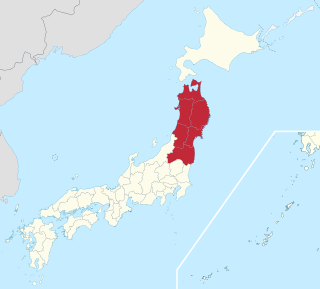
Iwate Prefecture is a prefecture of Japan located in the Tōhoku region of Honshu. It is the second-largest Japanese prefecture at 15,275 square kilometres (5,898 sq mi), with a population of 1,165,886. Iwate Prefecture borders Aomori Prefecture to the north, Akita Prefecture to the west, and Miyagi Prefecture to the south.

The Tōhoku region, Northeast region, Ōu region, or Northeast Japan consists of the northeastern portion of Honshu, the largest island of Japan. This traditional region consists of six prefectures (ken): Akita, Aomori, Fukushima, Iwate, Miyagi, and Yamagata.

In Japan, onsen are hot springs and the bathing facilities and traditional inns around them. There are approximately 25,000 hot spring sources throughout Japan, and approximately 3,000 onsen establishments use naturally hot water from these geothermally heated springs.

Hanamaki is a city in Iwate Prefecture, Japan. As of 31 March 2020, the city had an estimated population of 94,691, and a population density of 100 persons per km², in 37,773 households. The total area of the city is 908.39 square kilometres (350.73 sq mi). Hanamaki is famous as the birthplace of Kenji Miyazawa and for its hot spring resorts.

Ninohe is a city located in Iwate Prefecture, Japan. As of 31 March 2020, the city had an estimated population of 26,344, and a population density of 63 persons per km2 in 11,803 households. The total area of the city is 420.42 square kilometres (162.33 sq mi).

Nishiwaga is a town in Iwate Prefecture, Japan. As of 31 March 2020, the town had an estimated population of 5,468 in 2279 households, and a population density of 9 persons per km². The total area of the town is 590.74 square kilometres (228.09 sq mi). The total area was 825.97 square kilometres (318.91 sq mi).

Ginzan Onsen (銀山温泉) is an onsen area in Obanazawa, Yamagata Prefecture, Japan. Its name means "silver mine hot spring". Ginzan Onsen's economy grew due to silver mining and production and eventually transitioned to tourism when it opened dozens of hot spring resorts and ryokan along the central river that runs through the town. The mountains that surround this town yield rich hot spring water that is used both in the private hotels and public baths in the city center.

Kusatsu Onsen (草津温泉) is a hot spring resort located in Gunma Prefecture, Japan, northwest of Tokyo. It is a popular tourist destination.

Takayu Onsen (高湯温泉) is a hot spring resort in the Zainiwasaka district of the city of Fukushima, Fukushima, Japan. It is in the mountains about 14 km west of Fukushima Station.

Takanoyu Onsen (鷹の湯温泉) is one of several hot springs in the Akinomiya Hot Springs area of the city of Yuzawa, in southern Akita Prefecture. The onsen is nestled in a small gorge along the banks of the Yakunai River. Because of its secluded location, it is referred to as a Hitou, or hidden hot spring.

The Waga River is a river in Iwate Prefecture, Japan. From its headwaters near Mt. Waga in the Ōu Mountains it flows from north to south through the entire length of Nishiwaga Town before turning east through Kitakami City. The River enters the Kitakami River on the south side of the city opposite Mt. Otoko.

Beppu Onsen (別府温泉) is an extensive hot spring system in the city of Beppu, Ōita, Japan. There are eight distinct major thermal spring zones called "Beppu Hatto".

Sakan Ryokan or "Hotel Sakan" (ホテル佐勘) is an historic ryokan located in Sendai, Miyagi Prefecture, Japan. The inn is over 1,000 years old, and is located within the spa resort named "Akiu Spa," which has four communal onsen (baths) that are supplied by natural hot springs. The hot springs are one of the three oldest ones in Japan, and are located near the Natori River. The inn was originally started by a man named Kanzaburo Satoh, whom the inn is named after. Ownership of the inn has been handed down to Satoh's descendants for 34 generations. It is located next to the 400 year old Iwanumaya Hotel.

Kitakami Mountains is a mountain range in northeastern Honshu, in the Tōhoku region of northern Japan. The range extends for 250 kilometres (160 mi) from the southern border of Aomori Prefecture in the north to the northern border of Miyagi Prefecture in the south, and are bordered by the Kitakami River valley in the west and the Pacific Ocean to the east, with an average width of around 80 kilometres (50 mi).The Kitakami Mountains are thus mostly located within eastern Iwate Prefecture. The range is largely an eroded plateau with a thick granite bedrock, thus accounting for its other name: Kitakami Plateau. In the north, the mountains are characterized by marine terraces at an altitude of around 300 meters, whereas in the south, the mountains are drowned to form a deeply indented rias coast.

Shirasagiyu Tawaraya is a traditional Japanese ryokan (inn) established in 1190, the oldest in Yamanaka Onsen town, part of Kaga city in Ishikawa Prefecture, Japan. The hotel is operated by the same family for over 800 years, now up to the 25th generation.

Shima Onsen is a name of Japanese town and hot springs - onsen, the part of Nakanojō city in the Gunma Prefecture.

Unazuki Onsen is a hot spring resort located in the city of Kurobe, Toyama Prefecture, Japan, at the entrance of the Kurobe Gorge.

The Akinomiya Hot Springs also known as Aki no Miya Onsenkyo is a thermal spring system and hot springs village in the Akinomiya Geothermal Area located along the western base of Mount Kurikoma in Akita Prefecture, Japan,. There are more than 50 hot springs and fumaroles in the area.

Yunomine Onsen is a hot spring system and resort town in Tanabe, near Hongu Town in southern Wakayama Prefecture, Japan. The Tsuboyu bath is located there, a UNESCO World Heritage site.























